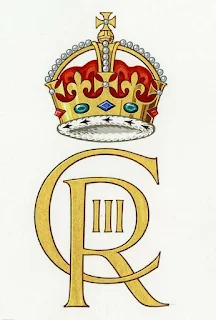Buckingham Palace released the official monogram or Royal Cypher of King Charles III. The cypher features the King's initial C intertwined with the letter R for Rex, the Latin word for "King" (Regina for Queen) as well as the Roman numeral III, indicating he is the third Charles to reign over the United Kingdom.
The first two Charles monarchs of Britain were from the House of Stuarts - King Charles I, the eldest surviving son of King James I. He was beheaded in 1649, the only British monarch to suffer such a grisly fate.
The second Charles was the eldest son of Charles I, he reigned over Britain in 1660 when the monarchy was restored. He had no direct descendants as his marriage with his wife, Princess Catherine of Braganza, did not produce any children.
But King Charles II had several illegitimate children from different mistresses, including the Duke of Richmond and the Duke of Grafton, the direct ancestors of Johnny Spencer, 8th Earl of Althorp, the father of Diana, Princess of Wales. Making Charles II, the ancestor of Prince William, the newly minted Prince of Wales.
Charles III's Cypher Crown
However, noticeable in King Charles III's new monogram is a crown different from his mother, Queen Elizabeth II's crown in her monogram. His cypher features a Tudor Crown above his initials. While Queen Elizabeth II's monogram featured the Edwardian's Crown above her initials.
 |
| Charles III's new monogram |
Why do they differ? According to Buckingham Palace, the new cypher of the king is his personal choice. He chose the design among all the designs presented to him by the College of Arms.
His reason for choosing the Tudor Crown representation above his initials is to signify the House of Windsor in the male line. And meant to honor his grandfather, King George VI, and great-grandfather, King George V.
Queen Elizabeth II's cypher
The St. Edward’s Crown, a Crown Jewel traditionally worn by the British monarch during their Coronation, was chosen by Kings George II, George III, George IV, Victoria, and Elizabeth II. While the Tudor crown was depicted on the cyphers of Edward VII, Edwards VIII, George V and George VI, and now Charles III.
However, Charles III's Scottish version of his cypher features the Scottish Crown, approved by the Lord Lyon King of Arms, and not the Tudor Crown, above his initials.
The Scottish version of Charles III's cypher
His Scottish version cypher feature's his initial C intertwined with the letter R for Rex - Latin for King - with III within the R denoting he is the third Charles to reign over the United Kingdom, and with the Crown of Scotland above the letters.
His new monogram will appear on items including state documents, postboxes and state signage, and will be used by government departments and by the Royal Household for franking mail.
King Charles' Face on Bank Notes
But while his new monogram will start to appear in all government departments, post boxes, Royal Household communication and items, his face won't appear on on bank notes for two years.
New bank notes with Charles III's face will be unveiled by the end of 2022 but won't be in public circulation until mid-2024. This is because the bank notes with Queen Elizabeth II's face are still in circulation and thus, continue to be legal tender.
The Royal Mint has confirmed that it is preparing coins featuring the portrait of the King but it has not revealed when they will begin circulating. All UK coins bearing the effigy of Her Late Majesty Queen Elizabeth II will also remain legal tender and in active circulation.
Bank of England Announcement
On Monday, September 27, the Bank of England announced that they will release updated notes featuring a portrait of His Majesty, King Charles III, by the end of this year. The notes are expected to enter circulation by mid-2024.
His Majesty’s portrait will appear on existing designs of all four polymer banknotes (£5, £10, £20 and £50). This will be a continuation of the current polymer series and no additional changes to the banknote designs will be made.
In line with guidance from the Royal Household to minimize the environmental and financial impact of the change of monarch, existing stocks of notes featuring HM Queen Elizabeth II will continue to be issued into circulation. New notes will only be printed to replace worn banknotes and to meet any overall increase in demand for banknotes.
Current banknotes featuring the portrait of HM Queen Elizabeth II will continue to be legal tender and will only be removed from circulation once they become worn or damaged. They will co-circulate with those featuring HM King Charles III.












0 Comments